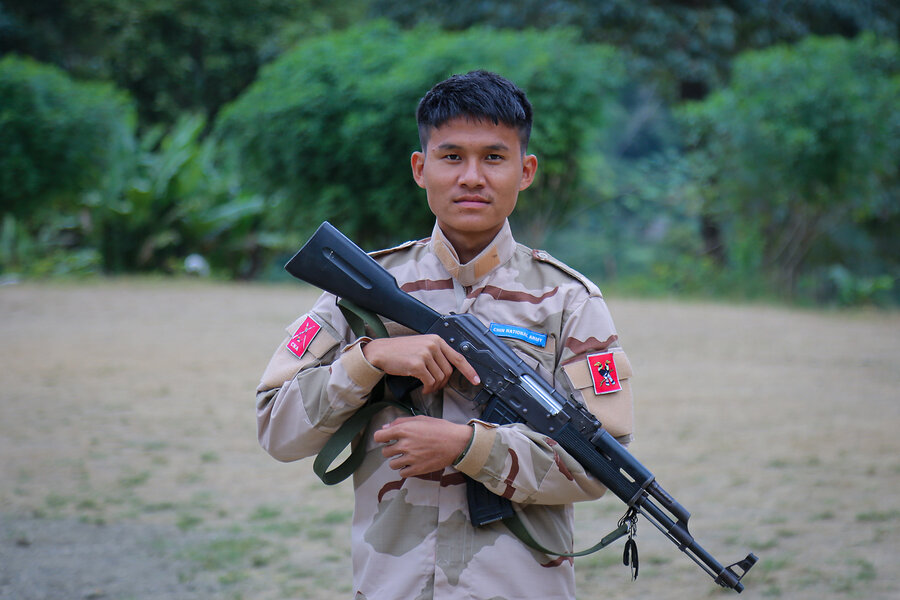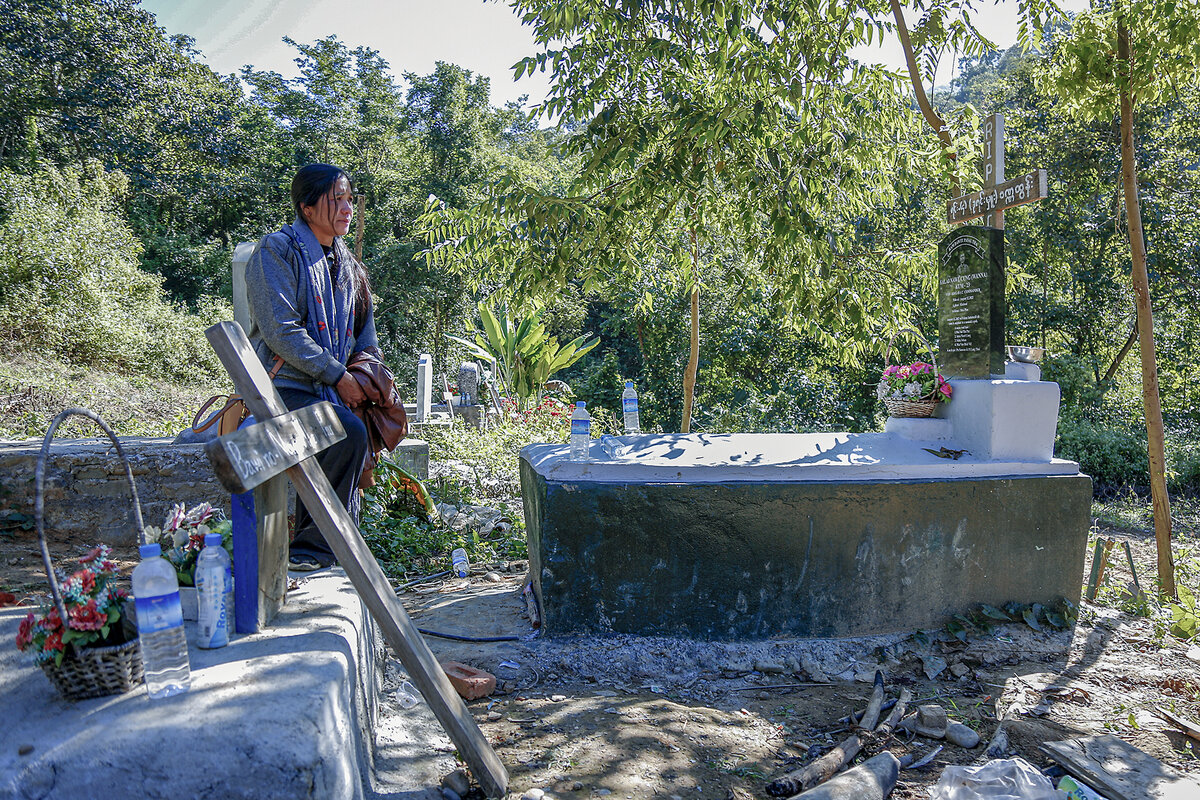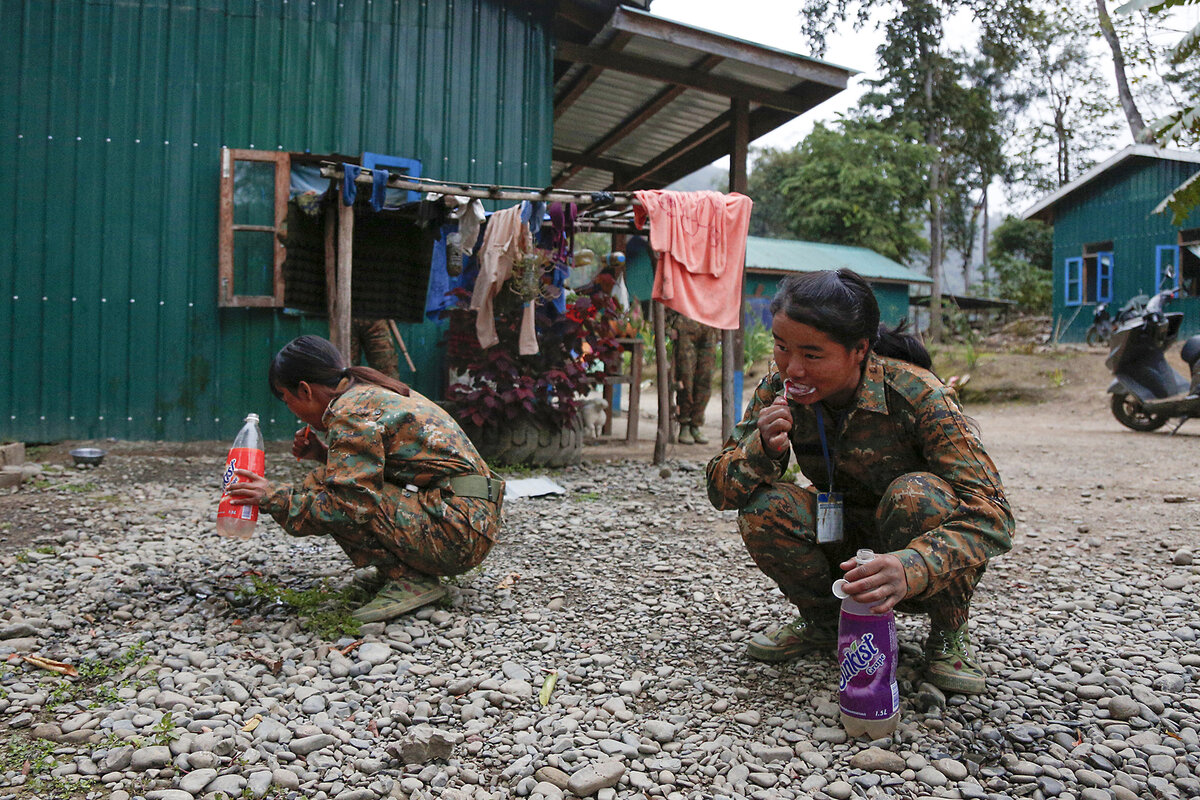Meet the young rebels fighting against Myanmar’s junta
Loading...
| Chin state, Myanmar
Joseph was studying law in Myanmar’s northwestern city of Sagaing when the military’s 2021 coup plunged the country into war.
The teenage law student – who like many in Myanmar has only one name – fled on foot to India with his parents, hoping to resume his mother’s cancer treatment across the border. But after spending weeks in a refugee camp in India’s Mizoram state, watching from afar as authorities violently quashed civilian protests and jailed elected leaders, he decided to return.
“I could not tolerate what they had done to my country and our future,” says Joseph, who is now an elite sniper with the Chin National Army, an ethnic rebel group based in the western Chin state. The CNA entered a cease-fire with the military in 2012 but resumed fighting, along with other armed ethnic groups across Myanmar, after the coup.
Why We Wrote This
A story focused onThe 2021 coup in Myanmar brought new blood into resistance groups. Their fresh ideas – and dedication – have been embraced by the old guard, helping build momentum against the junta.
Three years into the war, experts say Myanmar’s military, known as the Tatmadaw, is facing challenges like never before. Thanks to increased cooperation among historically fractured resistance groups, anti-junta organizations claim to now control more than half of the country. And within these groups, veteran fighters are embracing new recruits, who they say bring fresh ideas, passion, and technological savvy to battlefields and base camps across Myanmar.
“I have been fighting the military for quite a long time, and yet there is so much to learn about the field from these young fighters who came from colleges and universities,” says 50-year-old Baiklian, who has been part of CNA for the last 25 years and recently joined the group’s new dedicated drone department.
Learning to live with loss
When he joined CNA, Joseph went through months of rigorous military training at Camp Victoria, the group’s headquarters. He was a fast learner, getting promoted to the top sniper unit early on, and recently played a key role in capturing a police station in the Rezua area of Chin state.
“You need a lot of mental strength to be a sniper,” says Joseph, who is now 21 years old. “But I know this is for ... the democracy and liberation of my people.”
In addition to marksmanship, he’s learned that being a rebel fighter demands sacrifice. Joseph has not seen his family since joining the CNA. In June, while he was on the front line, his older sister joined a group fleeing Myanmar by boat, hoping to build a new life in Europe. He found out weeks after she had already left, and no one has heard from her since. He doesn’t know if she made it off the boat.
“This is what the coup does to ordinary people’s lives,” he says. But what saddens him the most is the death of his comrades.
He’s lost several close friends in combat, most recently Arosethang Tan Lin, who was killed by junta soldiers during a mission. When Joseph accompanied Mr. Lin’s parents to their son’s fresh grave, he couldn’t hold back his tears.
“We are losing young people to this war,” says Mr. Lin’s mother, Nibor, who is only 37 years old herself. “There can be nothing more painful.”
Powering through
Though the front lines are still dominated by men, veteran fighters say more women are joining CNA since the coup.
“Being a rebel fighter is not easy,” says Magtalin, a former engineering student and one of most acclaimed young women in the CNA, “but if you are a woman, things get more difficult.”
Magtalin’s rifle skills and aptitude for planning missions have won her accolades, and she’s become a role model for other women hoping to transition from office and security roles to combat. Yet even now, she says she’s never been on a mission with another woman.
“Many times, I have got my period while on a mission in some jungle,” says Magtalin, warming her hands around a fire she lit near her outpost. It’s hard to put into words how frustrating it is to have to fight and run with heavy equipment – often in the rain or biting cold – during these times, she says. “You cannot ask for a break in a battlefield."
But her commitment is unwavering.
“We will have to continue fighting,” she says. “No one is going to come for us.”
When Magtalin misses her old life, she puts on some makeup and swaps her olive-colored camouflage for a T-shirt and jeans, envisioning a future free of the junta and jungle battles. Had there been no coup, she would have likely finished her education and become an electrical engineer by now.
Recent battlefield gains by CNA and other rebels have revived hopes that this future is possible.
Cooperation leads to gains
Since October, rebel groups in northern and western areas of Myanmar have worked together to capture several towns and military camps. Baiklian, the veteran CNA fighter, says he has “never seen rebel groups in Myanmar so strong and coordinated” against the powerful junta.
One reason they’re seeing this new momentum, he believes, is that young fighters have brought drone technology to the rebel ranks, which has made a significant dent to the Myanmar military during the recent offensives. Young fighters use the internet to teach themselves how to make and modify drones for battlefield applications, and then share that knowledge with others. Baiklian says he recently learned how to modify drones to drop explosives onto enemy targets.
“It is immensely effective,” he says.
Overall, senior CNA fighters express gratitude – and a degree of surprise – over the wave of post-coup volunteers. According to CNA officials, about 70% of the group’s 5,000 members joined in the past three years. While an influx of inexperienced fighters could create tension, the blended ranks have fought harmoniously, at least in this corner of Myanmar.
Indeed, many CNA fighters are united in the belief that the solutions to all of Myanmar’s struggles – from political instability to lingering ethnic tensions to displaced and divided families – begin with getting the junta out.
Not unlike Joseph’s family, Baiklian’s wife and two daughters have been living in a refugee camp in India since the coup.
“I will not see my family till [the junta] are thrown out of power,” says Baiklian. “Revolutions are fought with a huge price.”









